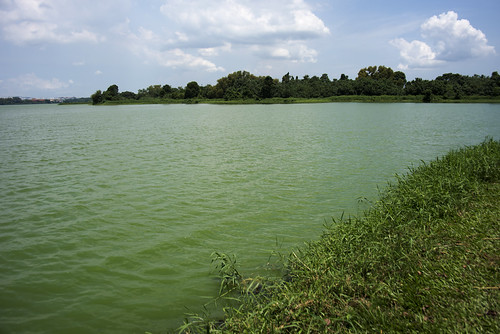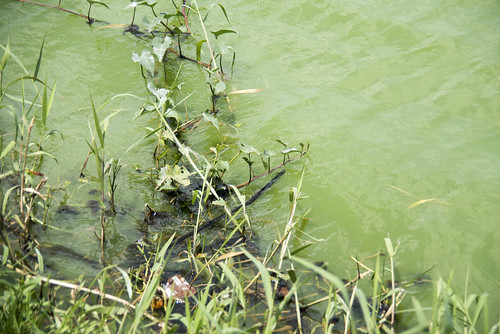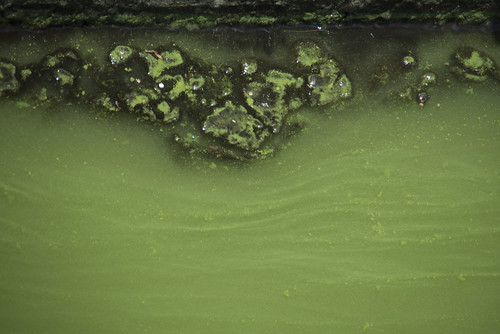I have no idea what caused it, but usually, such a phenomenon is attributed to a bloom of freshwater algae or cyanobacteria. What are the implications of such a bloom? In particular, will it affect people and marine life (and fish farming) in the Johor Strait nearby?
Here's what I saw at the Kranji Reservoir today. The water was the same shade of green as the cow grass growing next to it, as far as I could see.
A closer look at the green stuff in the water. There were filaments forming darker clumps on plants or objects floating in the water.
The water itself was an opaque bright green. I could see some strands of green filaments.
A concerned nature lover also shared these drone captures of the sluice gate of the Kranji Reservoir taken yesterday evening.
You can see the stark difference in colour between the bright green of the freshwater inside the Kranji Reservoir, and the darker colour of the water in the Johor Strait.
This green stuff in the Kranji Reservoir will enter the Johor Strait if the Reservoir sluice gate is opened. Nearby is Sungei Buloh Wetland Reserve and about 60 Singapore fish farms.
What are the possible impacts of massive freshwater algae being discharged into the Johor Strait?
Freshwater algae should not survive if they are released into the saltier waters of the Johor Strait. But in Florida last month, a toxic freshwater bloom that developed in a freshwater lake and was released into saltier waters did not die out. And instead flourished and cause massive damage.
In July 2016 it was reported that "Thick, Putrid Algae Bloom Overwhelms Miles Of Florida Coastline" with residents worrying about their health. Another article explains why the 2016 Florida bloom is particularly worrying:
While blooms of this nature are not uncommon in Lake Okeechobee, this one received more attention because of its intensity and size – it covered 33 square miles. Also, the bloom was exported to the coast when water managers released water from Lake Okeechobee in response to several months of heavy rainfall and concerns that rising water levels in the lake, which is contained by a dike, would cause flooding.
Upon reaching the coast, the bloom persisted instead of dispersing, causing economic damage to local tourism, fishing and boating businesses. Florida’s governor subsequently declared a state of emergency in three of the hardest-hit counties on the Atlantic coast and in one county on the Gulf coast.
Today, I had a quick look at Sungei Buloh Wetland Reserve at the Main Bridge. The were lots of lively wild fishes of various kinds swimming in the water that was NOT bright green.
The water was the usual colour and somewhat clear at some parts.
I also saw a crocodile!
I only saw three large dead fishes that looked like they were dead for some time. And I could smell dead fishes but couldn't see them.
By the way, I saw men working on some kind of construction at the sluice gate today.
As we head into warm weather and spring tides taper off, conditions become more and more conducive for algal blooms. Sigh.
You CAN make a difference: Dead Fish Alert!
Please help me monitor dead fishes washing up on the Johor Straits. Please let me know if you see large numbers (more than 10) especially of large dead fishes (more than 20cm long) washing up on the northern shores such as Pulau Ubin, Lim Chu Kang, Sungei Buloh, Kranji, Woodlands Waterfront, Sembawang, Punggol, Lorong Halus, Pasir Ris, Changi.
There are too many shores for me to personally check, so I really appreciate any info or photos that you can share. Thank you!
Here's high res photos of the green algal bloom at Kranji Reservoir are on wildsingapore flickr for download.
Update 14 Aug: The Straits Times covered this incident (also on wildsingapore news).
"The authorities told The Straits Times that the bloom has not affected fish in the reservoir or nearby fish farms and Sungei Buloh Wetland Reserve, although they are monitoring the situation.
Professor William Chen, director of Nanyang Technological University's Food Science and Technology programme, said freshwater algae blooms usually result from an excess of nutrients, which may originate from sources such as wastewater. The warmer weather this year may also have been a contributing factor, said Prof Chen.
He noted that decomposing algae consumes dissolved oxygen in the water, which can suffocate fish. Some species of algae can also produce potent toxins, which can affect fish and the ecology. Last year, an algae bloom between February and March wiped out over 500 tonnes of fish in 77 coastal fish farms off the East and West Johor straits.
A fishing enthusiast, who declined to be named, was seen casting his reel at the reservoir's fishing grounds yesterday. "The water has been green for a few months already. It's harder to catch fish because of lower visibility, and the fish seem a bit sluggish because of the lower oxygen levels," he said.
"But this happens sometimes when it's hot. I've seen worse."












